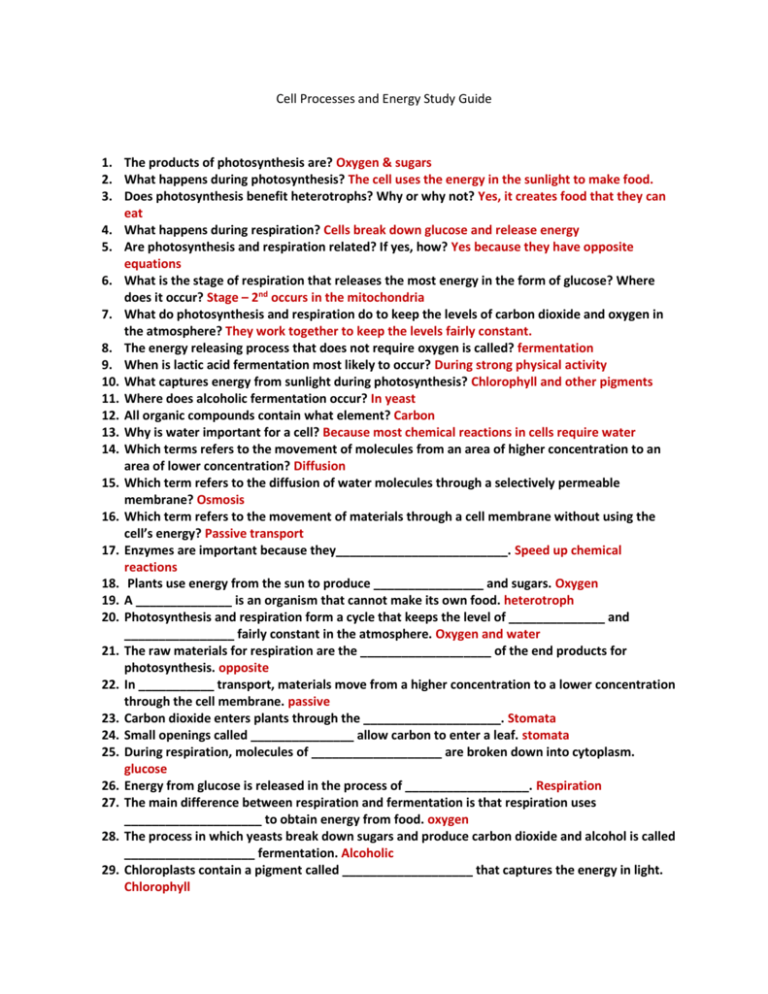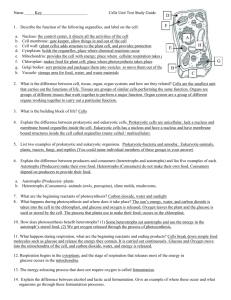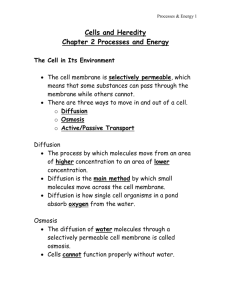Cell Processes & Energy Study Guide
advertisement

Cell Processes and Energy Study Guide 1. The products of photosynthesis are? Oxygen & sugars 2. What happens during photosynthesis? The cell uses the energy in the sunlight to make food. 3. Does photosynthesis benefit heterotrophs? Why or why not? Yes, it creates food that they can eat 4. What happens during respiration? Cells break down glucose and release energy 5. Are photosynthesis and respiration related? If yes, how? Yes because they have opposite equations 6. What is the stage of respiration that releases the most energy in the form of glucose? Where does it occur? Stage – 2nd occurs in the mitochondria 7. What do photosynthesis and respiration do to keep the levels of carbon dioxide and oxygen in the atmosphere? They work together to keep the levels fairly constant. 8. The energy releasing process that does not require oxygen is called? fermentation 9. When is lactic acid fermentation most likely to occur? During strong physical activity 10. What captures energy from sunlight during photosynthesis? Chlorophyll and other pigments 11. Where does alcoholic fermentation occur? In yeast 12. All organic compounds contain what element? Carbon 13. Why is water important for a cell? Because most chemical reactions in cells require water 14. Which terms refers to the movement of molecules from an area of higher concentration to an area of lower concentration? Diffusion 15. Which term refers to the diffusion of water molecules through a selectively permeable membrane? Osmosis 16. Which term refers to the movement of materials through a cell membrane without using the cell’s energy? Passive transport 17. Enzymes are important because they_________________________. Speed up chemical reactions 18. Plants use energy from the sun to produce ________________ and sugars. Oxygen 19. A ______________ is an organism that cannot make its own food. heterotroph 20. Photosynthesis and respiration form a cycle that keeps the level of ______________ and ________________ fairly constant in the atmosphere. Oxygen and water 21. The raw materials for respiration are the ___________________ of the end products for photosynthesis. opposite 22. In ___________ transport, materials move from a higher concentration to a lower concentration through the cell membrane. passive 23. Carbon dioxide enters plants through the ____________________. Stomata 24. Small openings called _______________ allow carbon to enter a leaf. stomata 25. During respiration, molecules of ___________________ are broken down into cytoplasm. glucose 26. Energy from glucose is released in the process of __________________. Respiration 27. The main difference between respiration and fermentation is that respiration uses ____________________ to obtain energy from food. oxygen 28. The process in which yeasts break down sugars and produce carbon dioxide and alcohol is called ___________________ fermentation. Alcoholic 29. Chloroplasts contain a pigment called ___________________ that captures the energy in light. Chlorophyll 30. Oxygen molecules move across cell membranes through a process called_______________________. Diffusion











